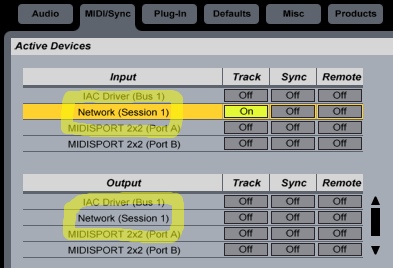Send HTML Email
Tuesday May 13th 2008, 7:50 am
Filed under:
InternetSending correctly-formatted HTML email can be a more complicated process than you might think. But the free, cross-platform Thunderbird email client is a decent solution.
Step 1. Click the Write button to compose a new message:

Step 2. Click in the body of the email.
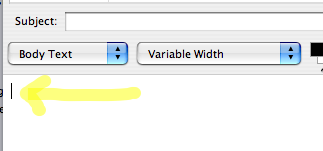
Step 3. Go to the Insert menu and choose HTML:
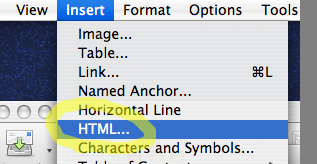
Step 4. Paste in your HTML code and then click the Insert button:
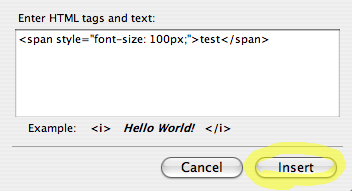
Step 5. You should now see a preview of your page in the body of the email:
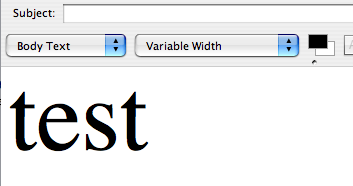
Step 6. Click the Send button:
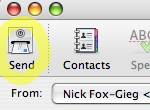
Step 7. Choose Send in Plain Text and HTML and click Send again:
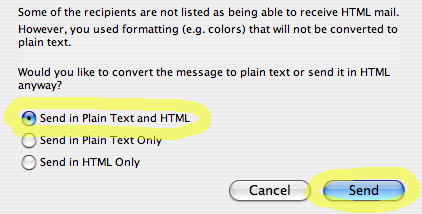
(Made with help from Jamie Ryckman.)
Easier Speech Transcription
Wednesday April 23rd 2008, 7:56 pm
Filed under:
SoundIf you need to transcribe speech in an audio file, there’s a nifty feature in the free version of Apple’s Quicktime Player that can help.
Step 1. Choose Show A/V Controls from the Window menu, or press Command-K:

Step 2. Adjust the Playback Speed slider:
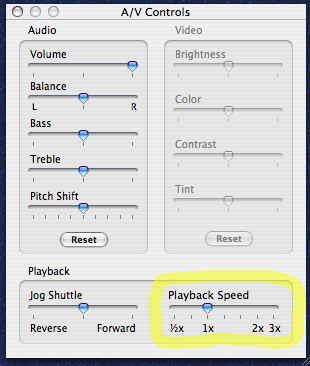
You can use this to slow down sound while keeping the pitch intact–perfect for transcribing at a relaxed pace.
Intel Applications in Rosetta
Intel Macs use Rosetta emulation to run PowerPC Mac software. Native Intel Mac software runs much faster, so ordinarily Rosetta is something to avoid if you can. However, if you Get Info on many Intel Mac apps…
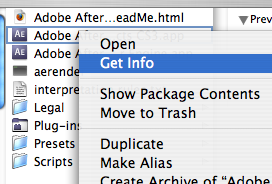
…you’ll see an option to run the program in Rosetta.

Why would you want to do this? Normally, you never would; you’d just be degrading performance horribly for no reason. But sometimes being able to emulate a PowerPC chip is worth the hassle. For example, what if you have to open an old After Effects file that uses lots of Power-PC-only plugins? Instead of having to find and install an old version of the same program, you can just pop into Rosetta mode and rescue your stuff.
Still, that little checkbox is an easy thing to overlook. Imagine if you accidentally forget to uncheck it on a computer shared between multiple users, not all of whom are savvy enough to realize why everything’s suddenly running so slowly! It would be better if we could create a dedicated shortcut for running the program in Rosetta mode, the kind of thing Windows users have been able to do for a while now:
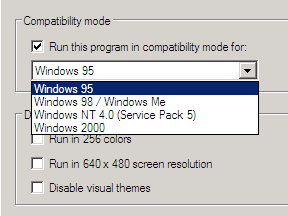
As it turns out, it can be done–it just takes a few steps.
Step 1. Right-click on the application and choose Show Package Contents:
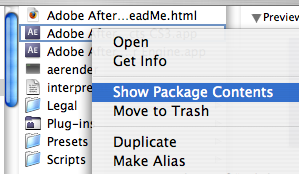
Step 2. Navigate to the folder MacOS and choose the main application file:
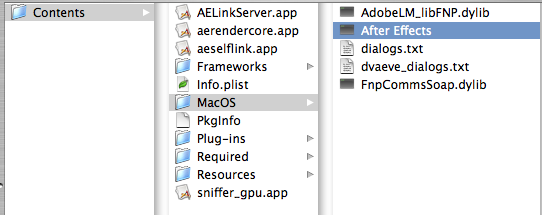
Step 6. Start the Terminal and drag the main application file into the Terminal window:

Step 7. This will spit out the full path to the application on your disk:

Step 8. Copy the path. Download this precooked shortcut, open it into a text editor, and replace the pathname with your own. (If you’re running After Effects CS3 on an Intel Mac, the shortcut should work the way it is.)
Make MP4s with VisualHub
Wednesday January 23rd 2008, 8:22 am
Filed under:
VideoThere are a lot of programs out there for compressing video, but I particularly recommend VisualHub (US$ 25), for OS X.
2012 note: VisualHub is now free, but won’t be supported past OS X Snow Leopard.
I prefer it even over fancier alternatives like Apple’s Compressor, not because of any special capabilities, but because of its clean interface and the straightforward way it presents your compression options. It’s especially useful it you’d like to fit your movie within a given file size–this is a common task, but too many programs require you to get there by trial and error.
(If anyone can recommend a good Windows program with the same ease-of-use factor, please do, and I’ll add a tutorial for it.)
Step 1. Drag your movie into the VisualHub window:
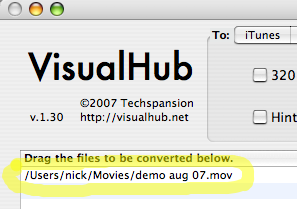
Step 2. Choose the MP4 tab and check H264 Encoding and Hint for Streaming. For very small file sizes, check 320 Pixels Wide too:

(The H.264 codec gives great results at tiny file sizes. It’s not meant for use in video production, though, so always keep your master copies in DV or another high-quality format.)
Step 3. If you’d like to specify a target file size, click on Advanced:
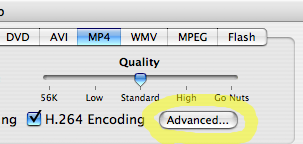
Step 4. Check Fit each video in… and type in a number:
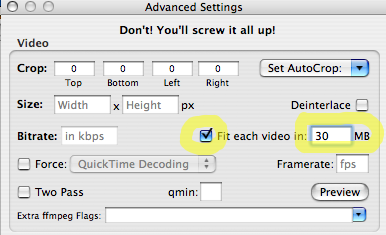
Step 5. Click Start to begin encoding:
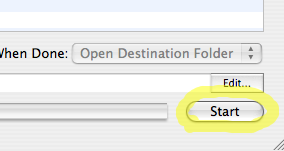
Setting up a Final Cut Project
Saturday January 12th 2008, 10:54 am
Filed under:
Final CutA lot of common problems in video editing can be avoided if you make sure you’re using the proper settings each time you create a new project. This is especially important to get right if you’re capturing from or recording to tape–typically, there’s only one combination of settings that will work for any given hardware device.
Settings to watch for include the size of your image in pixels, the number of frames per second, and the type of codec (a set of instructions the computer follows to draw your video on the screen) used. There are also some more arcane details to keep track of, having to do with how your video will display on an analog TV.
Fortunately, modern editing software spares you from memorizing all this stuff; in most cases you can just pick a preset off a list. However, you still have to be vigilant, because the same potential for trouble exists whenever these many variables aren’t all just right. The following advice is for Final Cut, but the principle’s the same for most comparable programs.
Step 1. The first thing you should do when starting a new project is go to the Easy Setup menu:
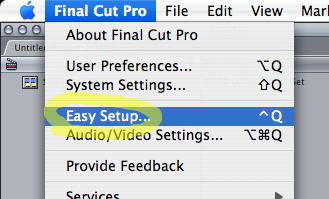
Step 2. Pick your preset off the pop-up list. For North America and parts of Asia, DV-NTSC is a good default choice. (You might need another option on this list; check your camera hardware or ask a friend for help.)
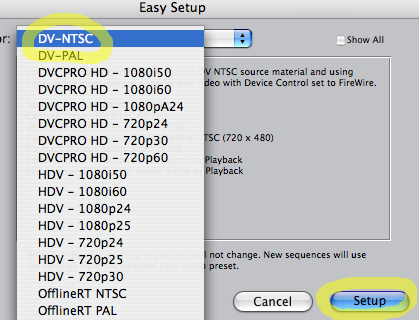
That’s it–all new sequences you create for this project will now conform to the settings you chose. If you’d like to change settings for an existing sequence, you have a few more steps left.
Step 3. Double-click your sequence in the Browser window to open it:

Step 4. Choose Settings from the Sequence menu:
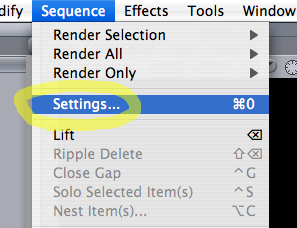
Step 5. Click on Load Sequence Preset:
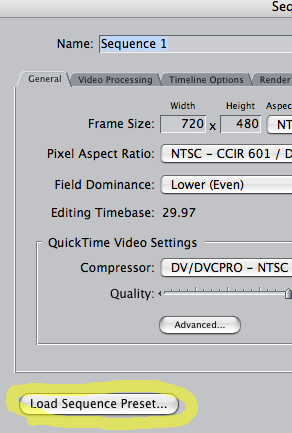
Step 6. You’ll see another list of presets, more extensive than in Easy Setup. Choose the one you need:
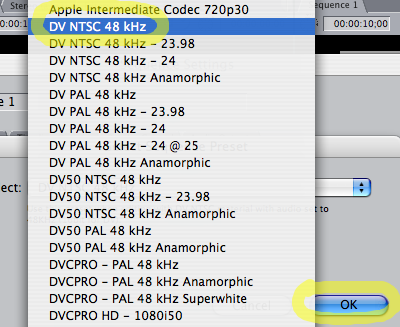
Remember, if you’re not sure what settings you need, ask before starting your project! At present, some settings for a Final Cut sequence already in progress can’t be changed. (Timebase, or frame rate, is a particular offender.) This limitation isn’t shared by other editing programs, and I hope it’ll be fixed in a future version of Final Cut.
USB 1 or USB 2?
Tuesday January 01st 2008, 11:48 am
Filed under:
HardwareUSB and Firewire have been in wide use for a decade now, and they’ve done a lot to usher in the modular, multi-purpose modern laptop, which rarely needs to be opened with a screwdriver in the course of normal use. Both come in different flavors, meant to connect different kinds of devices.
You shouldn’t have much trouble telling apart the three kinds of Firewire, because each has a uniquely-shaped jack. USB 1 and USB 2, however, look exactly the same.
USB 1 is much slower, and is meant for undemanding gadgets like mice, keyboards, tablets, and MIDI interfaces. USB 2 is required for everything else, like hard drives, memory sticks, and audio interfaces. Pretty much all computers sold in the past five years come with USB 2, but for older machines you may need to check before buying new equipment. Unhelpfully, the diagnostic screens for both OS X and Windows don’t make this important information easy to decipher.
1. For Windows, right-click on the My Computer icon and choose Properties:
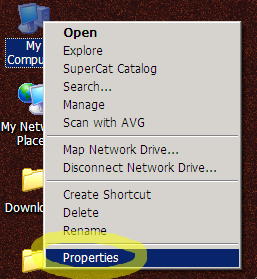
Go to the Hardware tab and choose Device Manager:
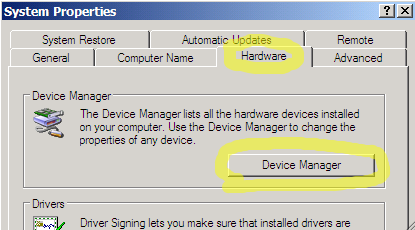
Click on the box next to Universal Serial Bus controllers:
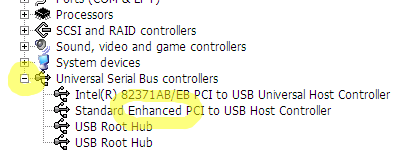
If you see the word Enhanced somewhere in the description of your USB hardware, you have USB 2.
2. For OS X, go to the Apple menu and choose About This Mac:
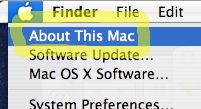
Click More Info:
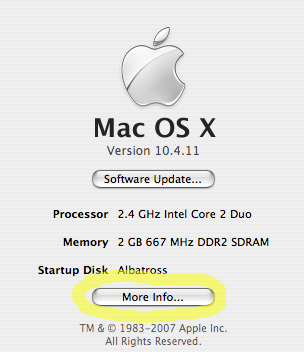
Choose USB:
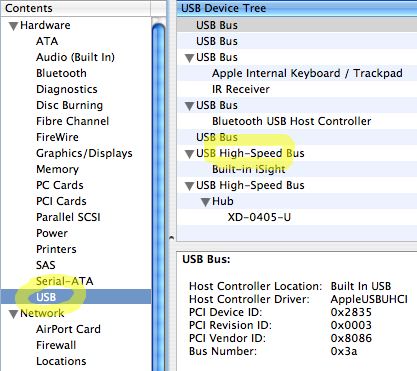
If you see the word High-Speed somewhere in the description of your USB hardware, you have USB 2.
If you don’t have USB 2, you’ll need to buy an add-in card. If you’re looking into this in order to work with video on an external hard drive, you may want to get a Firewire card instead; while not as versatile, it’s better-suited for that particular job. The cost of the cards is comparable, although Firewire hard drives tend to be more expensive.
Spotlight Cheat Sheet
Monday December 03rd 2007, 3:23 pm
Filed under:
OS X / MacOSHere are some useful commands for taming Spotlight, the powerful but often irritating content indexing tool introduced with OS X Tiger. These tips were taken from a Macintouch article by Robert Mohns.
1. Turn indexing on for a volume:
sudo mdutil -i on /Volumes/VolumeName
2. Turn indexing off for a volume:
sudo mdutil -i off /Volumes/VolumeName
3. Delete the index for a volume:
sudo mdutil -E /Volumes/VolumeName
4. Force a rebuild of the index for a volume (should happen automatically following a delete):
sudo mdimport -f /Volumes/VolumeName
5. Force a rebuild of the Mail.app index only:
mdimport -r /System/Library/Spotlight/Mail.mdimporter
Put the name of your target volume in place of VolumeName. If you’re running a command on the startup volume, you only need to use a forward slash (/).
There are two common scenarios where you’d want to use these commands.
1. Spotlight seems to start indexing at random. (This isn’t normal behavior.)
Delete the index for the startup volume; it’s probably corrupt. It should rebuild itself after:
sudo mdutil -E /
2. Spotlight insists on indexing external drives each time they’re mounted. (This is normal behavior, but it’s annoying.)
Using the command line, turn off indexing for each external drive:
sudo mdutil -i off /Volumes/VolumeName
If you’d just like to turn Spotlight off entirely, without having to type commands, you can use the Disable Tiger Features utility. Be warned that, while old-fashioned filename search still works without Spotlight, there are some odd side effects–for instance, you can no longer search for text in the body of emails using Mail.app.
Fix the Time in BootCamp
Tuesday September 04th 2007, 6:47 pm
Filed under:
OS X / MacOSApple’s BootCamp for Intel Macs is pretty handy, but for Tiger users it’s still a beta product with a few bugs. I think the most irritating of these is its habit of jumping the computer’s clock forward or back by a few hours whenever you switch between OS X and Windows. In Windows, the jumpy clock behavior cannot, at least as of the 1.4 beta, be helped. But you can at least put a stop to it in OS X. Unintuitively, you’ll need to solve the problem by editing the Windows Registry–one giant monster file that keeps track of all your Windows application settings.
This tutorial is based on instructions from Georg Filios at Mac OS X Hints.
Step 1. Boot into Windows and double-click on the clock to set it correctly.

Step 2. Make sure you have Daylight Savings adjustment and time server synchronization turned off. Make a note of what time zone you’re using.
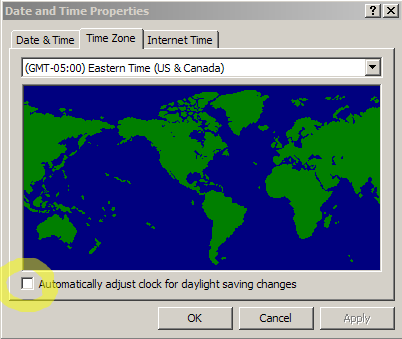
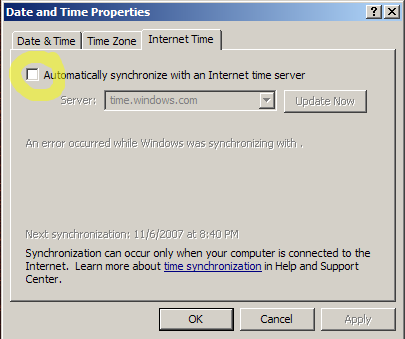
Step 3. Choose Run from the Start Menu:

Step 4. Type regedit to start the Registry Editor:
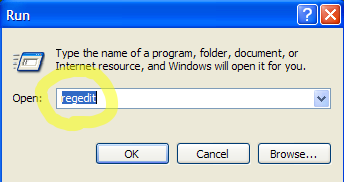
Step 5. In the Registry Editor, navigate to this directory:
HKEY_LOCAL_MACHINE\
SYSTEM\
CurrentControlSet\
Control\
TimeZoneInformation\
Step 6. From the Edit menu, create a new DWORD Value:
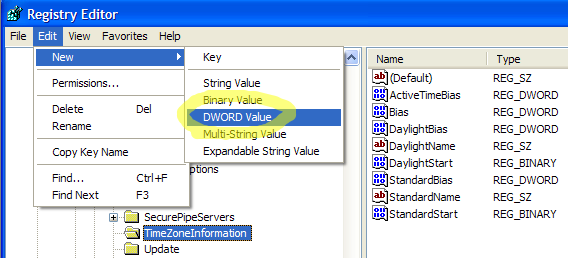
Step 7. Double-click on the new value you just created to edit it.

Step 8. Name it RealTimeIsUniversal (check your spelling again). Set the Value Data to 1 and leave the Base as Hexadecimal:
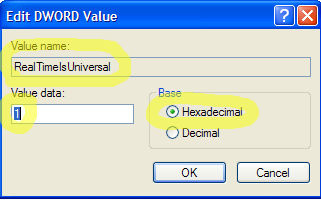
Step 9. Your finished Registry entry should look like this:
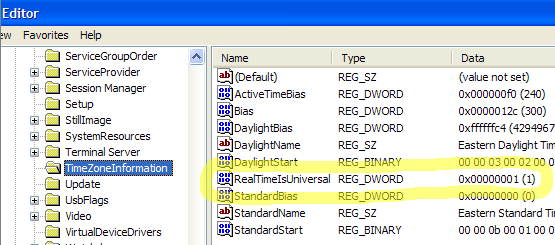
Step 10. Boot back into OS X and click on the clock to set it correctly. (If you’re using the Apple time server to set the clock, you can leave this on.) Make sure that you’re using the same time zone as in Windows.
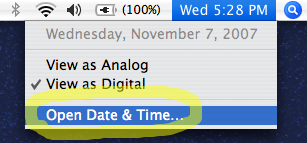
Try switching back and forth between OS X and Windows a few times–the OS X clock should now stay set!
CSS and Internet Explorer
Tuesday July 24th 2007, 4:23 am
Filed under:
InternetAll versions of Internet Explorer have problems correctly interpreting CSS. There are ways to improve IE compatibility, however, and one of the simplest is the following markup, called a doctype declaration:
<!DOCTYPE html PUBLIC "-//W3C//DTD XHTML 1.0 Transitional//EN"
"http://www.w3.org/TR/xhtml1/DTD/xhtml1-transitional.dtd">
Paste it at the top of your document, before anything else. See here for a detailed explanation of how it works.
MIDI Over a Network (OS X)
Thursday July 05th 2007, 3:01 am
Filed under:
MidiOS X Tiger includes a useful new feature: you can now send MIDI between computers over an ordinary network. You don’t need any additional hardware, and the connection appears as just one more ordinary MIDI port available to your applications. It’s a simple and effective way to have multiple laptop performers share control information, or to coordinate multiple computers during a live show.
Before starting this tutorial, you’ll need at least two OS X Tiger Macs that share a network. If you have WiFi, you can follow this tutorial first to create a direct wireless connection, without going through a router. (However you set it up, remember to turn off your firewalls first, or else make sure that they’re not going to interfere.)
Step 1. Find and launch the Audio MIDI Setup utility:

Step 2. Go to the MIDI Devices and open the Network device:
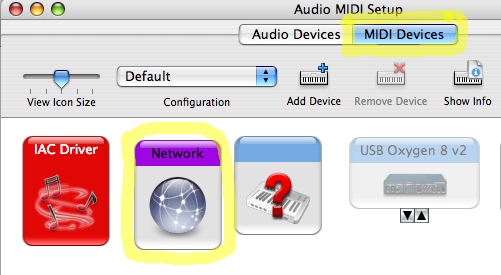
Step 3. To start with, use the following settings:
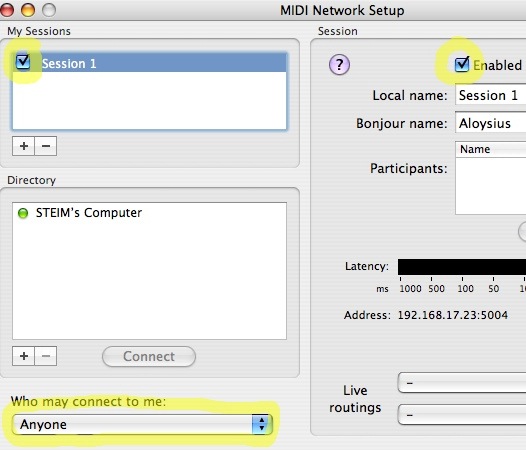
Step 4. Choose a computer from the list and connect to it:
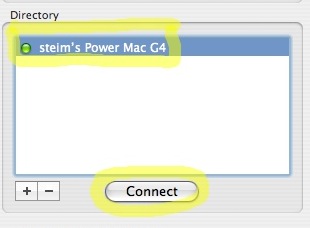
Step 5. If you’re successful, the computer will now appear in the Participants list. If you can’t connect, your network settings are most likely to blame. (Check to see whether you can do other ordinary network tasks, like copying files from the other computer.)
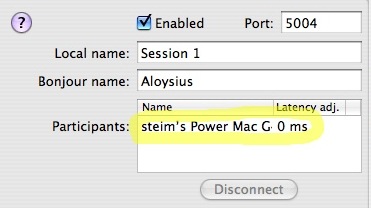
Note: On some older Macs, closing the Audio MIDI Setup utility appears to break the connection. Try it and see–if you have this problem, you’ll have to keep the utility running to stay connected.
Step 6. If everything has gone smoothly, you’ll have created a new MIDI Port with the name Network (Session 1). Select it from inside a MIDI program and test it out!
